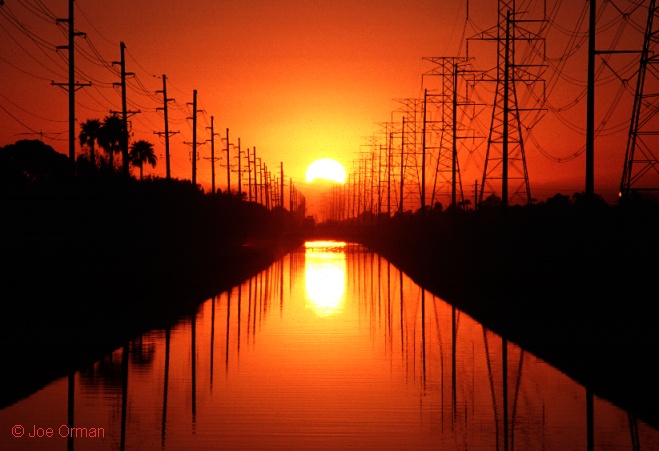This year’s northern hemisphere autumnal equinox, that day when the sun crosses the ecliptic on its way south, arrives at 5:05 a.m. EDT on September 23. On this day, and on its counterpart in March, the sun rises due east and sets due west everywhere on Earth, and at the equator, the subsolar point (the location on Earth directly under the center of the sun) occurs at noon.
Sunrise along an east-west canal:

Subsolar point, illustrated at the solstice from my alma mater’s geography department:
Are you ready?
In Boca Raton, where I live, the sun will rise at 6:09 a.m. and set at 6:16 p.m. That means that the day length will be slightly longer than 12 hours, and the night length slightly shorter (12 hours, 7 minutes and 11 hours, 53 minutes, respectively).
Hey, wait a minute!
I thought that day and night were the same length on the equinox!
Well, no. Just because the sun rises and sets due east and west, respectively, on this day, doesn’t mean that the length of day and night are the same. As I’ve explained before on these pages,
This is NOT the day of the year when day and night are the same length, despite the opinions of many learned people (geographers included!) to the contrary. The reason for this is that sunrise and sunset are defined by the edges of the sun’s disk first appearing (at sunrise) and last disappearing (at sunset). No matter where you are on Earth, it takes some amount of time for the sun to rise, although that time varies with the angle of the sun’s path and your position relative to the equator.
This physical size of the sun (half a degree, or 30 “minutes” as astronomers and celestial navigators might say) means that the sun will take, um, let’s see, 15 degrees an hour means 4 minutes per degree means, roughly, 2 minutes from the time the leading edge touches the horizon until the trailing edge appears above/disappears below it. So two extra minutes on each end means 4 minutes more daylight than night time.
But wait. There are 7 extra minutes on the equinoctial day here in Boca; where do the other three come from? Those have to be chalked up to refraction: the visible image of the sun in our sky near the horizon is actually refracted slightly from its true position due to the distorting effects of the miles and miles of atmosphere through which the rays must pass. This means that, in the morning when you first see the rising sun, it actually hasn’t physically gone above the horizon yet! And at night, when it sets, it’s actually been below the horizon for a brief time as well.
And that is why, although it’s close, day and night are NOT equal on the equinox. For my location, the “day of equity” is September 27, according to the US Naval Observatory:
| Day | Rise | Set |
|---|---|---|
| 19 | 608 | 1820 |
| 20 | 608 | 1819 |
| 21 | 608 | 1818 |
| 22 | 609 | 1817 |
| 23 | 609 | 1816 |
| 24 | 610 | 1815 |
| 25 | 610 | 1814 |
| 26 | 610 | 1813 |
| 27 | 611 | 1811 |
| 28 | 611 | 1810 |
| 29 | 612 | 1809 |
| 30 | 612 | 1808 |
Another interesting point about the equinoctial sun: it isn’t “directly overhead” at noon except on the equator (and points within 1/4° north or south, because, remember, the sun is about 1/2° wide). For everywhere else on Earth, the sun’s altitude at local noon equals 90 minus your latitude.
For example, here in Boca Raton, it will be at 90 minus 26, or 64° above the southern horizon. (Furthermore, it won’t happen at noon; on the equinox it will happen at 1:13 p.m. EDT. 1 p.m. because of the hour wasted on daylight “saving”; 13 minutes because the sun is about 13 minutes “late” getting to noon this time of year. For more on this, you need to understand the equation of time, which tells you how far ahead or behind the “mean” sun you are.)
During the summer solstice, when the sun is as far north as it can get, it’s still a good 2.5° south of the true zenith, because our latitude is 2.5° north of the Tropic of Cancer (the northernmost limit of the-sun-overhead-at-noon latitudes).


